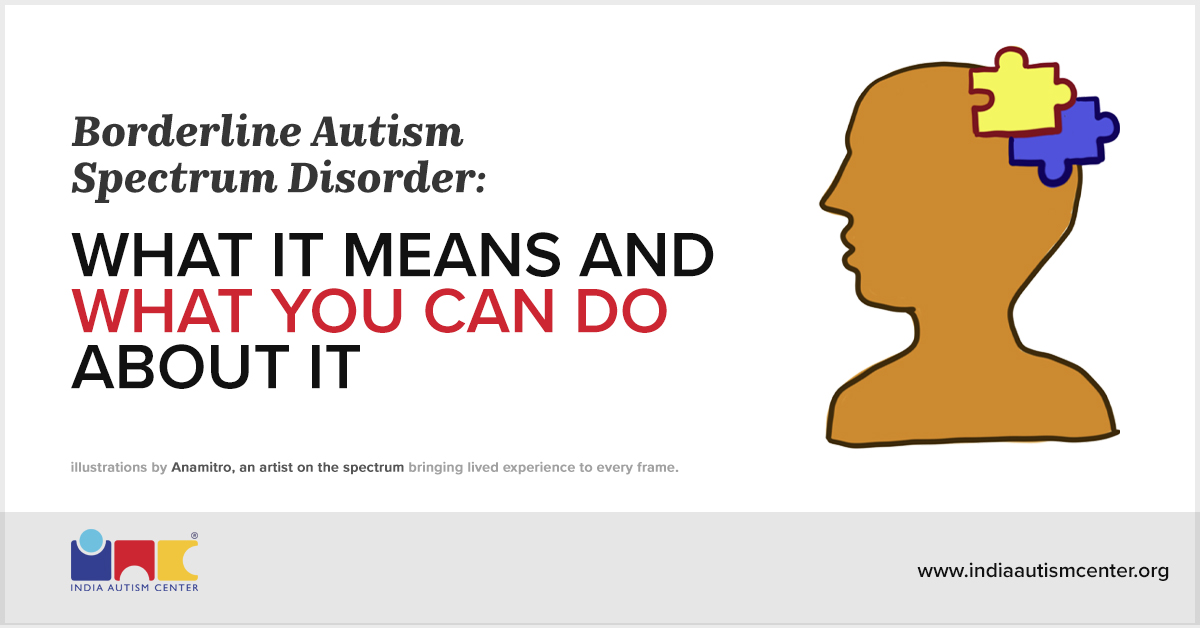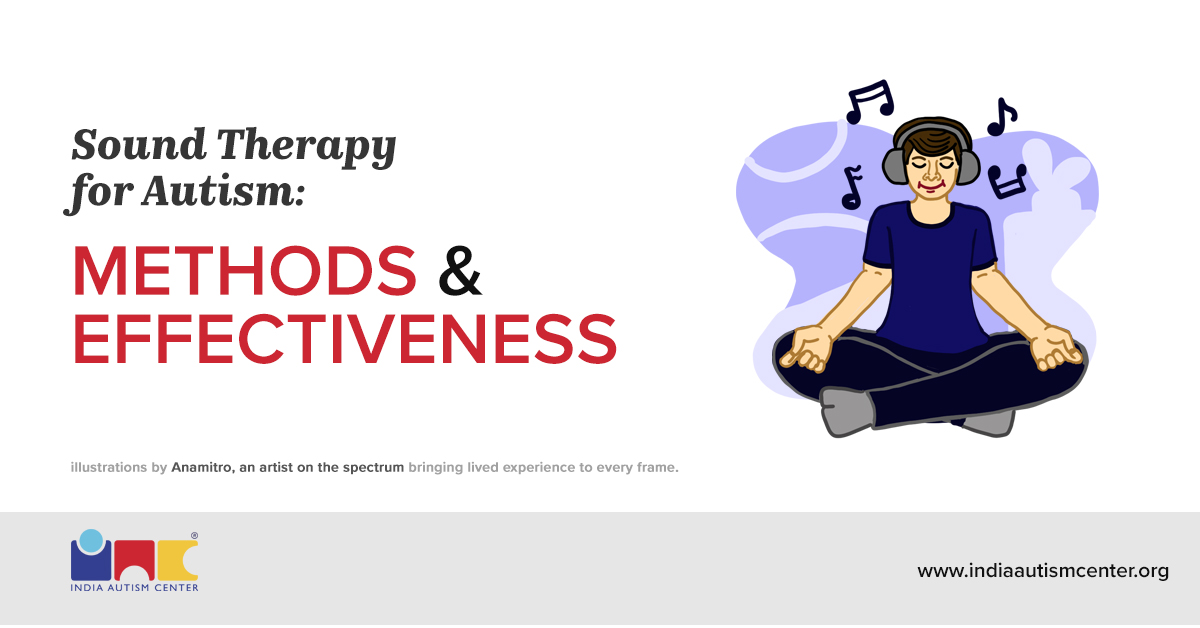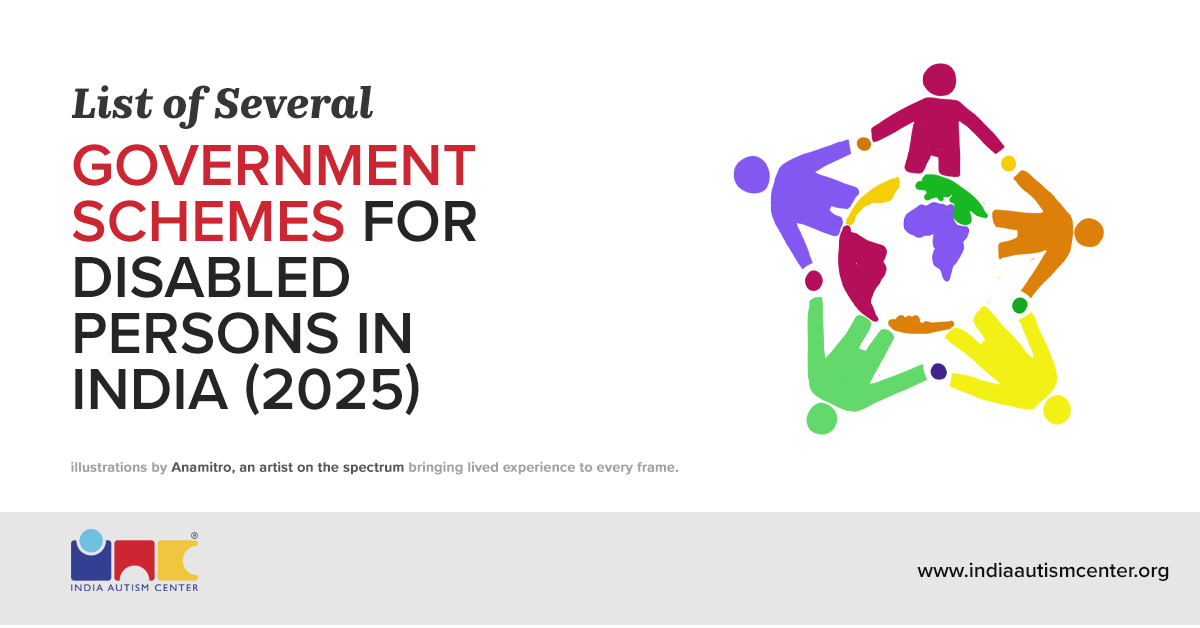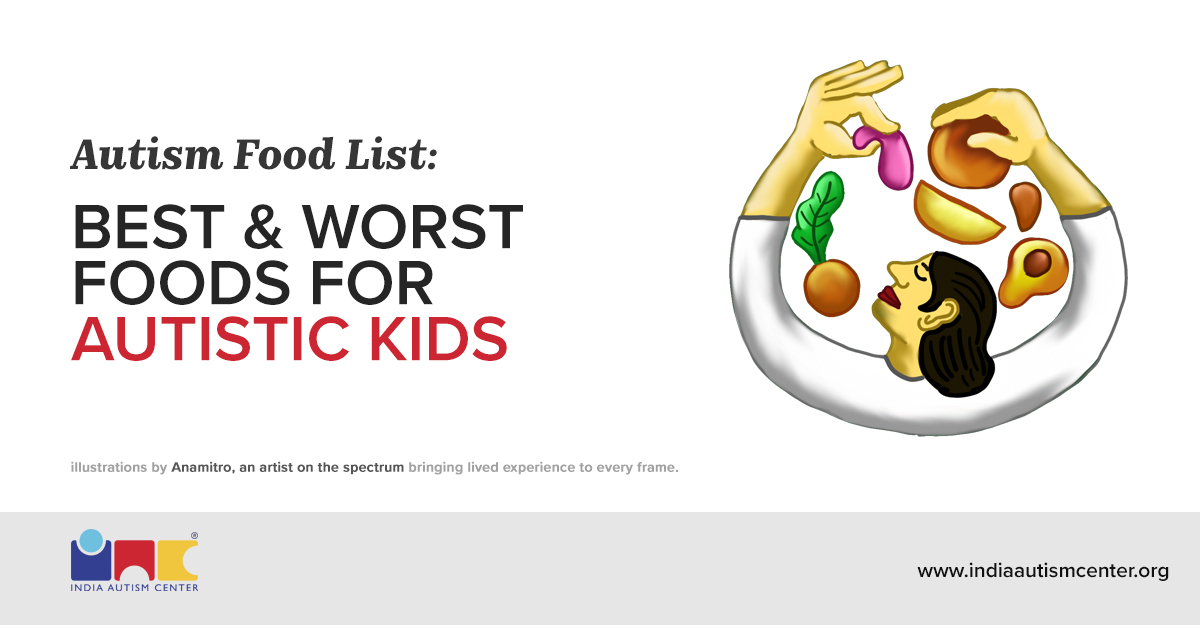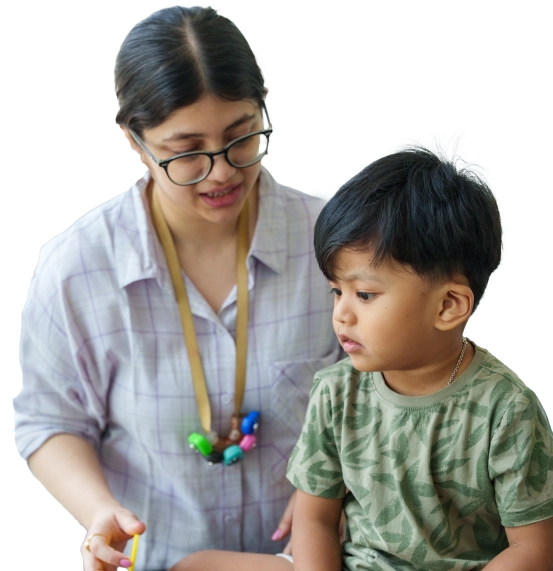You’ve probably seen the ‘classic portrayal’ of autism spectrum disorder (ASD). The textbook symptoms. The checklists. Maybe even real-life experiences supporting someone with a diagnosis.
But then you hear the term borderline autism spectrum disorder, and you stop in your tracks.
Is that even a thing?
Clinically, no. You won’t find it listed in the DSM-5 (Diagnostic and Statistical Manual of Mental Disorders). Yet many people identify with traits that feel almost autistic, but don’t meet the full criteria for diagnosis.
This in-between space is where the term borderline autism often comes in. And in this article, we’ll unpack what borderline autism means, why it’s frequently misunderstood, and how to recognize the signs.
So, let’s begin.
What Is Borderline Autism Spectrum Disorder?

Borderline autism spectrum disorder describes individuals who display certain signs of autism spectrum disorder but do not meet the full diagnostic criteria outlined in the DSM-5.
In other words, it is not an official diagnostic category but rather an informal term sometimes used by clinicians, educators, and families.
The common characteristics of borderline autism may include:
- Sensory sensitivities (e.g., strong reactions to sounds, lights, textures, or smells)
- Difficulty interpreting social cues or navigating social situations
- A strong preference for routine and predictability
Even though these individuals may not receive an autism diagnosis, their borderline autistic symptoms can still significantly affect daily functioning, relationships, and emotional well-being.
Describing Borderline Autism Through a Clinical Lens
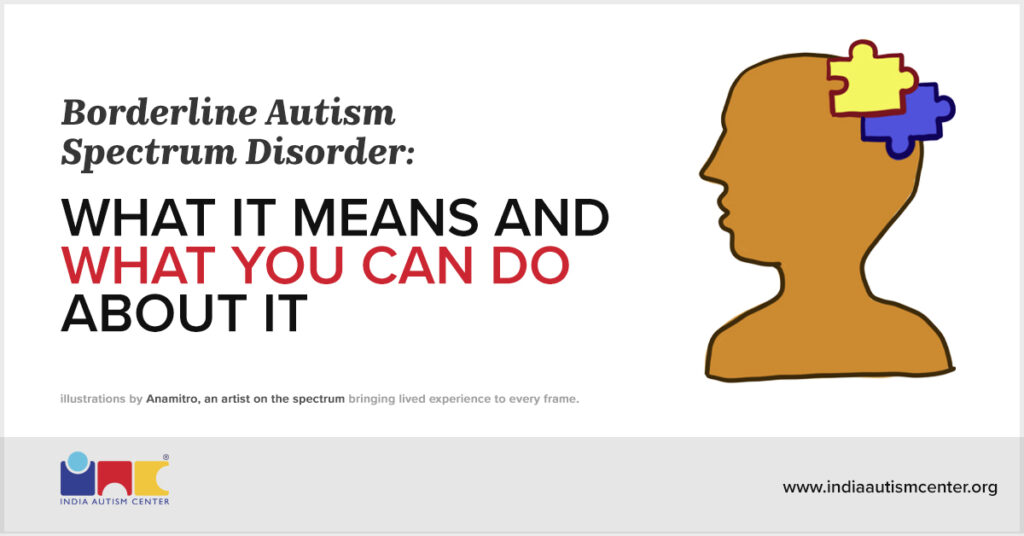
From a professional perspective, borderline autism significantly overlaps with the mildest form of autism, known as Autism Spectrum Disorder Level 1 (ASD 1).
The difference is largely in degree, not kind. For example:
- A child who just meets the diagnostic threshold may receive an ASD Level 1 diagnosis
- Another child with nearly identical traits, but slightly less pronounced, may remain undiagnosed, despite still struggling with borderline autistic symptoms
Why the Term ‘Borderline’ Can Be Confusing
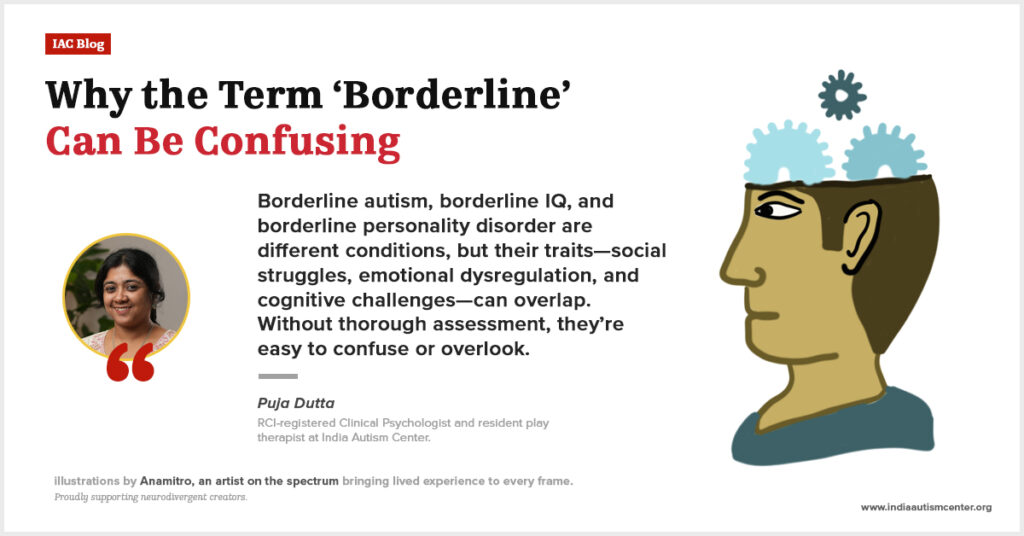
The term ‘borderline’ is also used in other diagnostic contexts, such as borderline intellectual functioning or borderline personality disorder (BPD).
While these conditions have completely different clinical meanings, in practice, traits can sometimes overlap. This makes assessment more complex.
As Puja Dutta, an RCI-registered clinical psychologist at India Autism Center, explains,
![]()
Borderline autism, borderline IQ, and borderline personality disorder are distinct terms. But we often see overlaps in clinical settings. The traits, such as social difficulties, emotional dysregulation, and cognitive challenges, often intersect. Without a thorough assessment, these profiles are easy to confuse or miss altogether.
That’s why it is crucial to view each person carefully and as an individual. Labels alone do not provide the complete picture. Understanding how someone thinks, feels, and operates in different areas of their life is essential.
Borderline Autism Spectrum Disorder Signs and Symptoms Across Ages
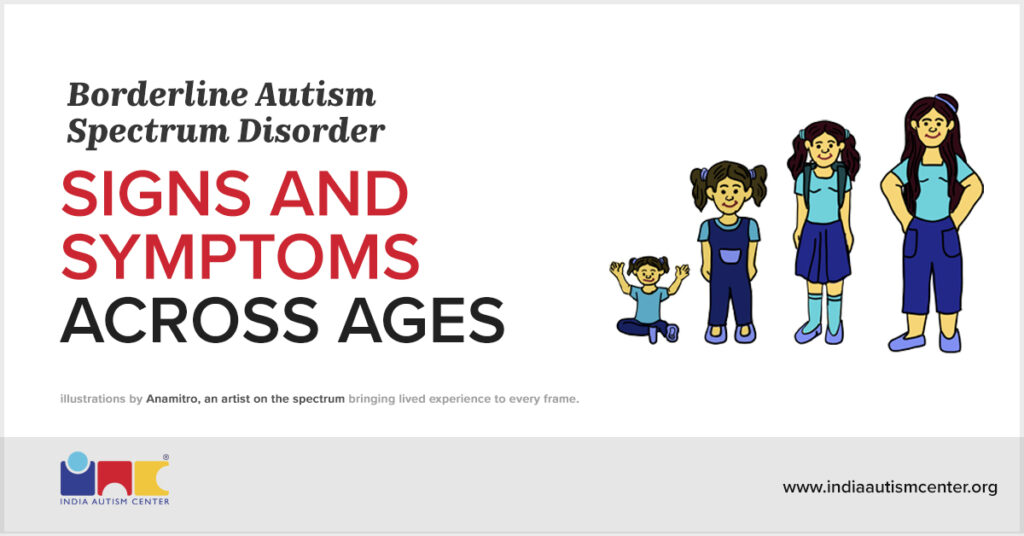
Borderline autism spectrum disorder often reveals itself gradually. Less as one defining moment and more as a slow layering of subtle signs.
What starts as sensitivity in early childhood may evolve into social exhaustion in adolescence and emotional burnout in adulthood.
Let’s break down the most common borderline autism symptoms across ages, so you can better understand how the presentation may change over time.
Borderline Autism Traits in Childhood (Ages 2–12)
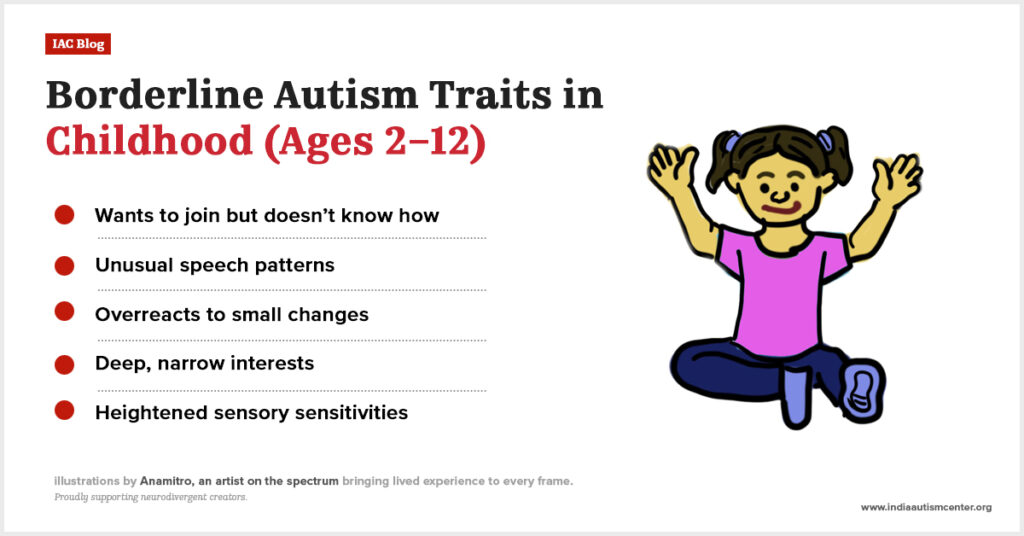
In early and middle childhood, the signs can be subtle. As a result, they are often misinterpreted as shyness, sensitivity, or personality traits.
Common symptoms may include:
- Wants to join but doesn’t know how: Prefers solo or parallel; struggles with group activities or sharing.
- Unusual speech patterns: No major delays, but may speak in a formal tone and echo others’ words.
- Overreacts to small changes: Distressed when routines shift, clothing feels uncomfortable, or environments change unexpectedly.
- Deep, narrow interests: Talks extensively about specific topics (e.g., trains, machines) without gauging others’ interest.
- Heightened sensory sensitivities: Overreacts to sounds, textures, smells; may cover ears, avoid certain clothes or foods.
- Masking at school, releasing at home: Imitates peers to blend in, but pays the emotional cost later.
- Literal interpretation of language: Misses humor, metaphors, or sarcasm, causing social misunderstandings.
- Motor coordination challenges: Struggles with handwriting, sports, or balance, sometimes overlooked as clumsiness.
Borderline Autism Symptoms in Teens (Ages 13–19)
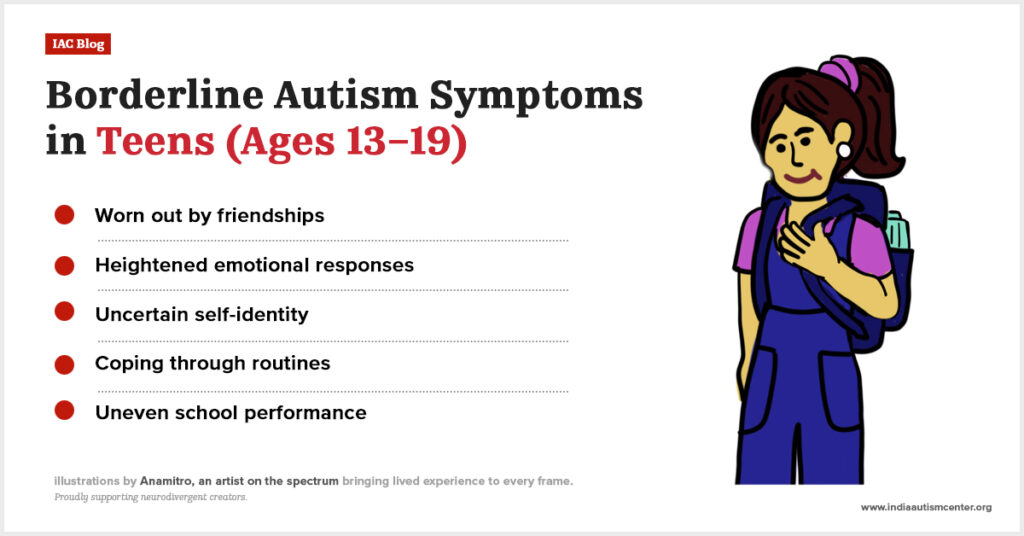
During the teenage years, social demands often become more intense. This makes it harder to sustain masking strategies.
The traits commonly appear as follows:
- Worn out by friendships: Tries to maintain social circles but finds interaction confusing and draining.
- Heightened emotional responses: Experiences intense mood swings, shutdowns, or outbursts tied to sensory overload or stress.
- Uncertain self-identity: Feels different but can’t pinpoint why; may adopt different personas in various settings.
- Coping through routines: Uses repetitive behaviors, rituals, or familiar structures to self-soothe.
- Uneven school performance: Excels in certain subjects but struggles with time management, organization, and adapting to change.
Signs of Borderline Autism in Adults (20s and Beyond)

By adulthood, individuals often rely on structure and self-management. While they may function well outwardly, challenges often persist internally.
The borderline autism in adults typically manifests in:
- Socializing feels scripted: Maintains relationships but requires conscious effort, leaving them mentally drained.
- Miscommunication in close relationships: Difficulty reading emotional cues or managing mismatched expectations in dating and friendships.
- Burnout after high performance: Alternates between peak productivity and emotional crashes, often misunderstood as laziness or mood issues.
- Difficulty with ambiguity: Feels uneasy with unclear instructions, open-ended tasks, or unpredictable environments.
- Identity shaped by masking: Unsure of authentic self due to years of role-playing to fit societal norms.
- Focused but inflexible interests: Deep engagement in certain topics or hobbies, sometimes limiting adaptability.
- Persistent sensory sensitivities: Overwhelm from loud noises, crowded spaces, or strong smells, even if well-hidden.
- Reliance on structure: Uses strict routines, lists, or plans to maintain emotional stability and reduce anxiety.
Think You Need a Diagnosis for Borderline Autism? Here’s What to Do

Seeking a borderline autism diagnosis can feel like navigating uncharted territory.
These borderline autism traits might not meet full DSM-5 criteria, but can still impact relationships, school, work, and mental health. Left unrecognized, they can lead to chronic stress, burnout, and even misdiagnoses such as anxiety, ADHD, or personality disorders.
As Puja explains,
![]()
We need to treat mental health like physical health. If something feels off, have it checked out. Just as we schedule regular physical check-ups, developmental and mental health check-ins should be routine, too.
Having said that, here’s a step-by-step roadmap to get started:
Track Daily Experiences

Keep a journal to record the specific challenges you encounter in daily life, focusing on:
- Social interactions
- Sensory sensitivities
- Rigid or repetitive routines
For example, if you feel drained after socializing or overwhelmed by small disruptions, write it down. These patterns will support your case for a clinical autism assessment.
This brings us to the next step.
Consult a Qualified Specialist
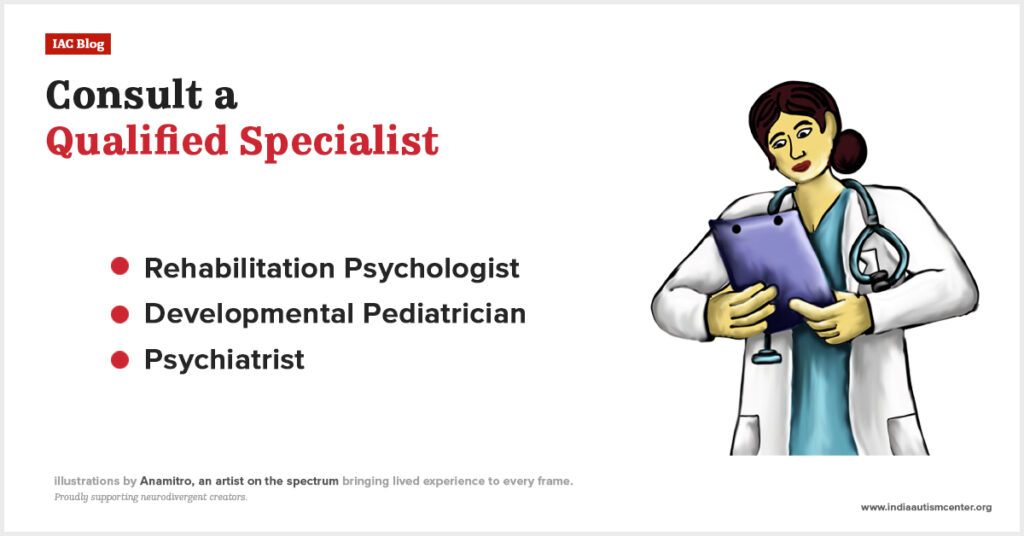
Different professionals can guide the process of identifying borderline autism or related conditions:
- Clinical or Rehabilitation Psychologist: They can conduct comprehensive psychological assessments using autism-specific diagnostic tools, such as the Indian Scale for Assessment of Autism (ISAA) and the Childhood Autism Rating Scale (CARS), among others.
- Developmental Pediatrician: This specialist focuses on childhood development and is skilled in identifying early signs of autism and how these traits evolve.
- Psychiatrist: They can evaluate individuals for autism as well as for co-occurring conditions like anxiety, attention deficit hyperactivity disorder (ADHD), or mood disorders. They may also manage medications if necessary.
Gather Outside Observations
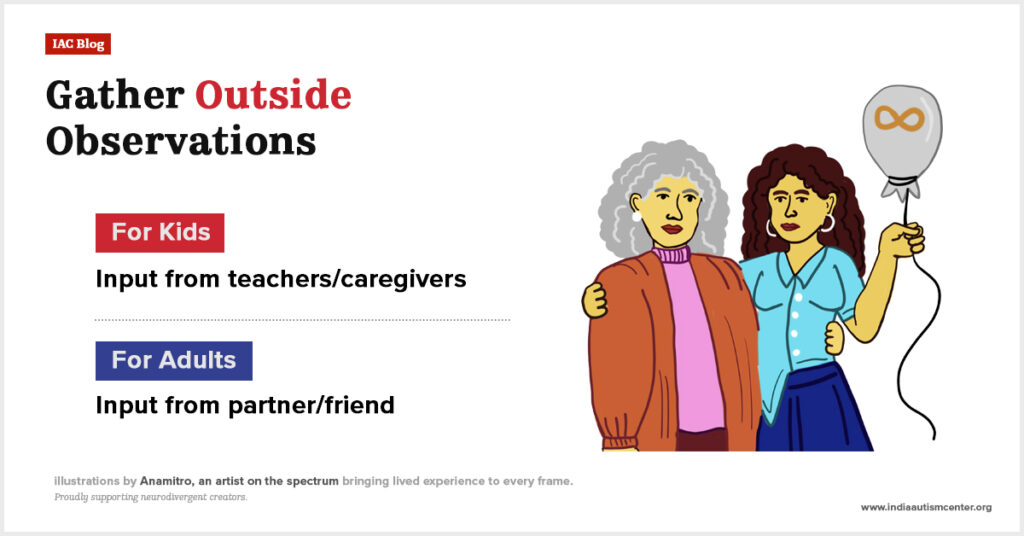
If you’re a parent seeking answers for your child, observations from teachers, special educators, or caregivers can offer valuable context.
For adults, feedback from a partner or close friend can offer valuable context.
Prepare for a Nuanced Outcome
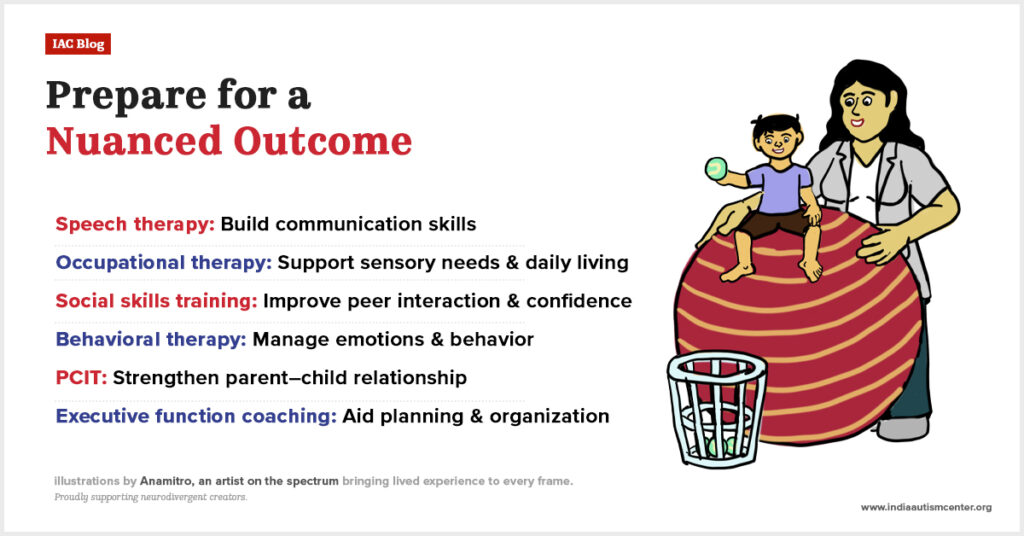
Not everyone who identifies with autism will receive an ASD diagnosis. For example, in cases with subthreshold traits, you may be directed toward symptom-based interventions rather than a formal autism care pathway.
That could include:
- Speech therapy for communication support
- Occupational therapy for sensory and daily living skills
- Social skills training for confidence in group settings
- Behavioral therapy for regulation
- Parent–Child Interaction Therapy (PCIT) to strengthen relationships
- Executive function coaching for organization and planning
Explore Broader Supports
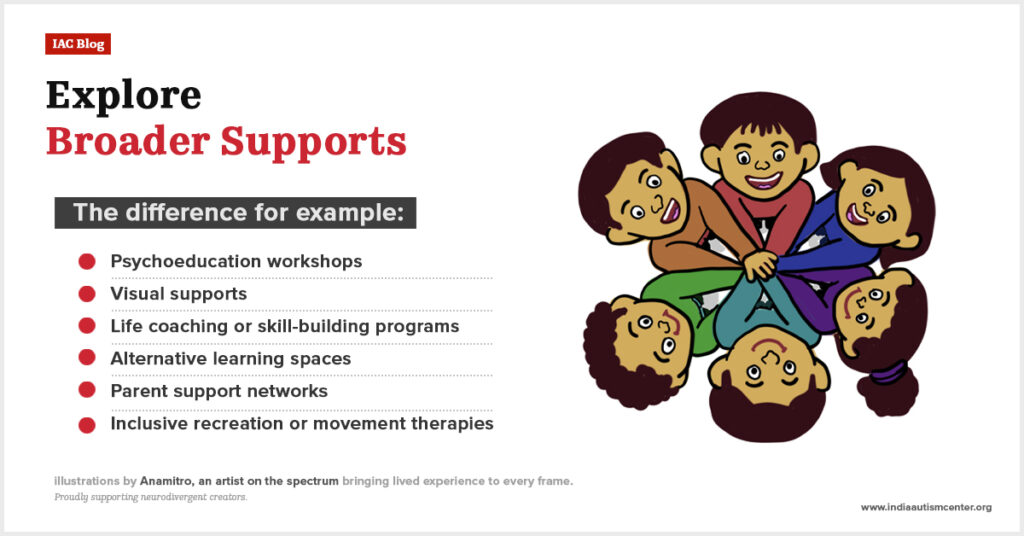
Even if you don’t meet all the diagnostic criteria for autism, there are still various types of support that can help make daily life easier.
Here are some lesser-talked-about supports to consider:
- Psychoeducation Workshops: Designed for parents, teachers, and caregivers to better understand sensory needs, emotional regulation, and effective ways to provide support without causing overwhelm.
- Visual Supports: Tools such as visual schedules, social stories, and checklists can help reduce anxiety and assist with transitions and planning.
- Life Coaching or Skill-Building Programs: These programs focus on fostering independence in areas such as time management, self-advocacy, and job readiness, making them especially beneficial for teens and adults navigating ambiguous situations.
- Alternative Learning Spaces: Montessori, Waldorf-inspired, or flexible learning centers provide environments that respect diverse sensory and cognitive styles.
- Parent Support Networks: These local or online communities offer guidance, emotional support, and shared experiences.
- Inclusive Recreation or Movement Therapies: Activities like art therapy, dance movement therapy, or structured sports groups are designed to support neurodivergent individuals in a low-pressure, expressive environment.
Why So Many Females Relate to Borderline Autism
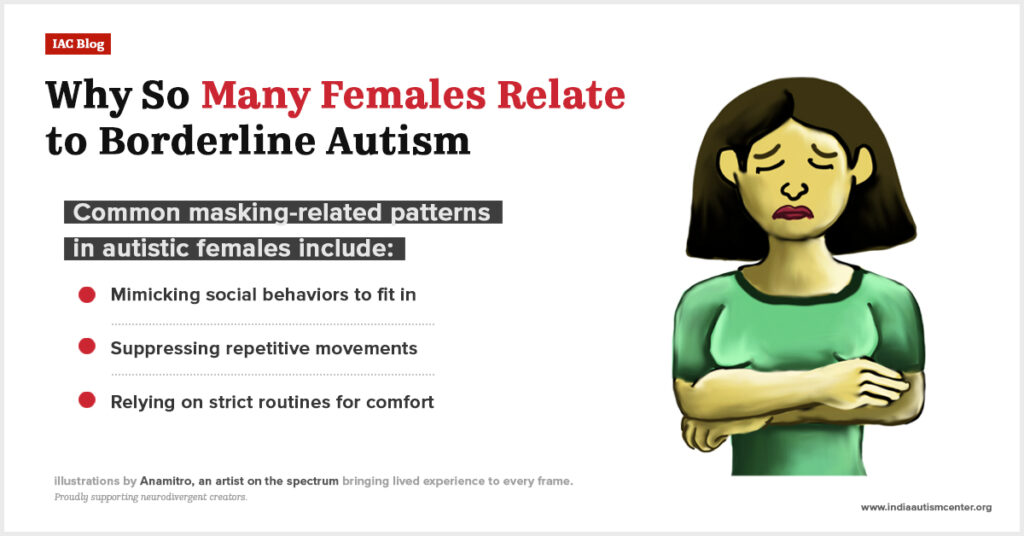
The borderline autism traits are prevalent in females. After all, signs of autism in women often present in less visible and harder-to-detect ways compared to males.
As Puja puts it,
![]()
Many girls exhibit internalizing symptoms that are not always recognized as signs of autism. Consequently, these children are often labeled as shy, sensitive, or moody, which leads to their actual needs being overlooked. By adolescence, they find themselves in a challenging situation and struggle to cope while remaining undiagnosed.
One of the biggest reasons for this under-recognition is masking or camouflaging. This refers to the deliberate effort to appear ‘typical’ in social situations.
Common masking-related patterns in autistic females include:
- Mimicking social behaviors to fit in
- Suppressing repetitive movements (like rocking, fidgeting, or tapping)
- Relying on strict routines for comfort
Over time, constant masking can lead to emotional fallout. This is frequently misinterpreted as depression, anxiety disorders, borderline personality traits, or simply stress.
The rise in adult diagnoses, especially among women, shows that this pattern is finally being recognized.
The concept of borderline autism has played a key role here for several reasons:
- It helps those who exhibit borderline autistic traits but do not meet the strict criteria for a diagnosis
- It addresses individuals who may have been misdiagnosed or overlooked during childhood
- It provides support for people who need assistance, even if they do not have a formal ASD label
By understanding the female presentation of autism, especially at the borderline level, we can enable earlier recognition, reduce misdiagnosis, and create support systems that meet their needs.
Parting Words: You Don’t Need an Autism Diagnosis to Deserve Support
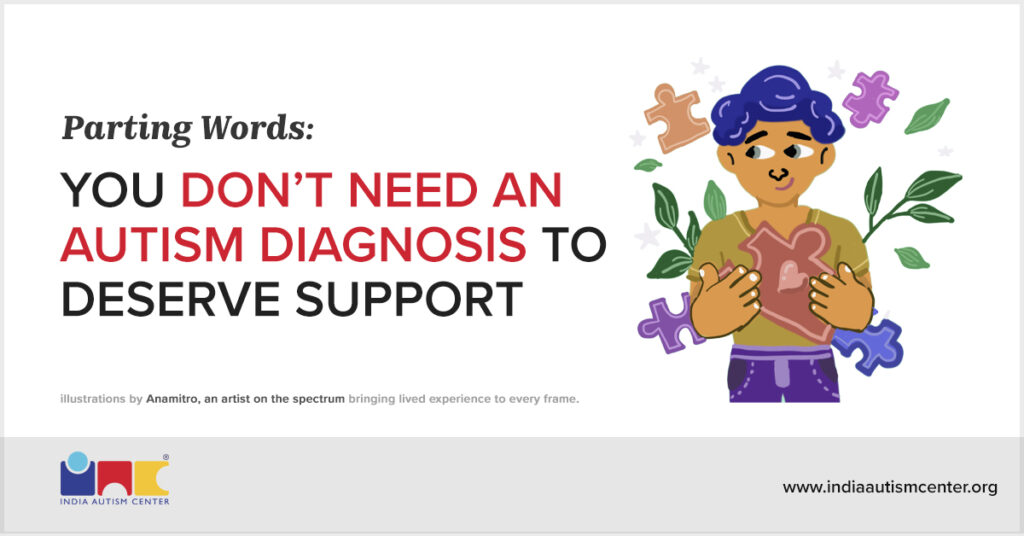
While borderline autism spectrum disorder is not an official clinical term, the experiences it describes are real, valid, and deserving of empathy.
Whether or not you meet every diagnostic criterion, your struggles and needs matter. Access to support, understanding, and self-acceptance is just as essential for those in the gray areas of the spectrum as it is for those with a formal diagnosis.
For further assistance, feel free to contact us.
Frequently Asked Questions
Is ADHD borderline autism?
No. ADHD and borderline autism are distinct conditions. While they may share features like inattention, impulsivity, or difficulties with social interactions, they are not the same. However, ADHD and autism can co-occur, which sometimes makes diagnosis more complex.
Can borderline be mistaken for autism?
Yes. Borderline personality disorder or other emotional regulation difficulties can sometimes be confused with autism. Both may involve challenges with relationships, communication, and managing emotions. That said, autism is a neurodevelopmental condition present from early childhood, while borderline personality disorder usually develops in adolescence or early adulthood. A professional evaluation is key to distinguishing between them.
What is the lowest form of autism?
There is no ‘lowest form’ of autism. Autism exists on a spectrum, and clinicians sometimes refer to ‘Level 1 autism’ (also called mild autism) to describe individuals who require minimal support. These individuals may still face difficulties with social communication or flexibility, but often manage daily life independently.
Can a child with mild autism live a normal life?
Yes. Many children with mild autism (or Level 1 autism) can live independent and fulfilling lives. With early intervention, therapy, and the right support systems, they often learn coping strategies that help them navigate social, academic, and professional challenges.
How serious is mild autism?
Mild autism is not considered serious in the sense of preventing independence. However, it can still significantly impact social relationships, school performance, or workplace adaptation if left unsupported. The seriousness depends on the individual’s environment, available resources, and coping strategies.
Do kids outgrow mild autism?
Autism is a lifelong condition, so children do not outgrow it. However, with timely early intervention and ongoing support, many children with mild autism develop skills that reduce the visibility of their challenges. They may appear to outgrow traits, but in reality, they’ve learned strategies to adapt.
Why do some people with borderline autism chew on objects?
Chewing or mouthing objects is common in individuals with borderline autism. It can serve as a self-soothing behavior to manage anxiety, sensory overload, or restlessness. Chewing provides oral sensory input that helps regulate emotions. Offering safe alternatives like chewable jewelry can help meet this sensory need.
Can borderline autism be cured?
No. Autism, including borderline or mild presentations, cannot be cured. It is a lifelong neurodevelopmental condition. However, with therapy, structured support, and coping strategies, many individuals learn to manage challenges effectively and thrive in personal and professional life. The focus is on support and empowerment, not a cure.

